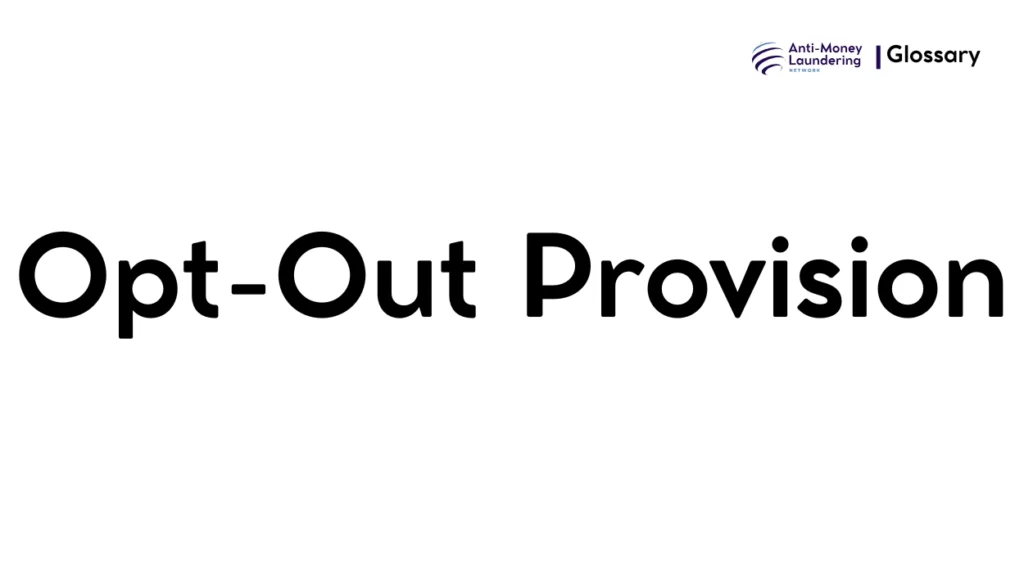Definition
The “Opt-Out Provision” in Anti-Money Laundering (AML) refers to a regulatory or procedural allowance that permits certain individuals, entities, or transactions to be exempted, under specific conditions, from some or all AML compliance requirements or due diligence processes that are normally mandatory. This provision allows regulated institutions to “opt-out” of certain AML obligations when predefined criteria are met, thereby streamlining compliance efforts while managing risk appropriately.
Purpose and Regulatory Basis
The opt-out provision serves to balance the need for AML vigilance with operational efficiency, especially in scenarios where the AML risk is deemed low or sufficiently mitigated by alternative measures. It recognizes that a one-size-fits-all approach in AML could be overly burdensome and cost-inefficient.
Key global and national regulations influencing opt-out provisions include:
- FATF Recommendations: While FATF (Financial Action Task Force) guidelines emphasize comprehensive AML controls, they allow for risk-based approaches, which can in practice incorporate opt-out mechanisms if justified by risk assessment.
- USA PATRIOT Act: In certain cases, the Act permits financial institutions to adopt risk-based procedures for customer due diligence, which can include opting out of enhanced due diligence for some low-risk clients.
- EU AML Directive (AMLD): The EU AML directives promote a risk-based approach to customer due diligence, often allowing member states or institutions to waive specific AML checks under tightly regulated conditions.
When and How it Applies
Opt-out provisions apply in real-world use cases when:
- Customers or transactions present a low risk of money laundering or terrorist financing, based on credible evidence or previous verifications.
- Certain types of accounts or products are standardized and have safeguards in place reducing AML risk.
- There is a legal or regulatory exception recognized by the jurisdiction.
For example, a financial institution might opt-out of collecting full beneficial ownership information on accounts that are government entities or low-risk organizations, upon validated documentation.
Types or Variants
- Full Opt-Out: Complete exemption from specific AML checks (rare and tightly controlled).
- Partial Opt-Out: Limited exemption, e.g., waiving only enhanced due diligence but retaining basic customer verification.
- Conditional Opt-Out: Opt-out allowed only if certain criteria are met, such as thresholds for transaction size or customer type.
Procedures and Implementation
To implement opt-out provisions, financial institutions generally follow these procedures:
- Conduct a thorough risk assessment to classify the client or transaction risk level.
- Apply documented criteria and controls to determine eligibility for opt-out.
- Obtain appropriate approvals internally, often involving the AML compliance officer.
- Document the rationale and maintain records justifying the opt-out decision.
- Continuously monitor and review opt-out cases to ensure no emerging risks.
Systems and controls like AML software, customer risk scoring, and compliance audits support this process.
Impact on Customers/Clients
From the customer’s perspective, opt-out provisions mean:
- Reduced data collection or simplified onboarding.
- Faster processing and fewer compliance-related interventions.
- However, customers must still comply with other regulatory requirements, and opt-out can be revoked if risk changes.
Duration, Review, and Resolution
Opt-out statuses are not permanent and require periodic review:
- Institutions must set review intervals based on risk level and regulatory expectations.
- If circumstances change, such as suspicious activity arises, the opt-out can be withdrawn and full AML checks applied.
- Records of reviews and decisions must be maintained.
Reporting and Compliance Duties
Institutions using opt-out provisions must:
- Maintain rigorous documentation to prove compliance with regulatory frameworks.
- Report suspicious activities regardless of opt-out status.
- Ensure internal audit and regulatory inspections can verify opt-out decisions.
- Non-compliance or misuse of opt-out provisions can lead to significant penalties.
Related AML Terms
The opt-out provision relates closely to:
- Risk-Based Approach (RBA): The foundation for justifying opt-outs.
- Customer Due Diligence (CDD) and Enhanced Due Diligence (EDD): Procedures from which opt-outs might exempt.
- Suspicious Activity Reporting (SAR): Obligations always maintained despite opt-outs.
- Beneficial Ownership: Information sometimes exempted under opt-outs.
- Know Your Customer (KYC): The overall process that opt-out provisions adjust.
Challenges and Best Practices
Common challenges include:
- Ensuring consistent and defensible risk assessments.
- Avoiding overuse that might expose the institution to AML risks.
- Training staff to correctly identify opt-out eligibility.
Best practices involve: - Clear written policies for opt-outs.
- Strong governance and oversight by AML officers.
- Regular audits and compliance reviews.
Recent Developments
Recent trends in AML emphasize stronger risk-based frameworks with new technologies like AI for monitoring risks dynamically, which could refine opt-out decisions. Regulators also emphasize transparency and accountability, ensuring opt-outs don’t undermine AML goals.
The Opt-Out Provision in AML is a regulated exemption allowing financial institutions to waive certain AML checks under clear conditions, supporting efficiency without compromising risk controls. It exists within risk-based AML frameworks like FATF, the USA PATRIOT Act, and EU AMLD. Proper procedures, documentation, and ongoing oversight are essential to responsibly manage opt-outs and maintain AML compliance.

